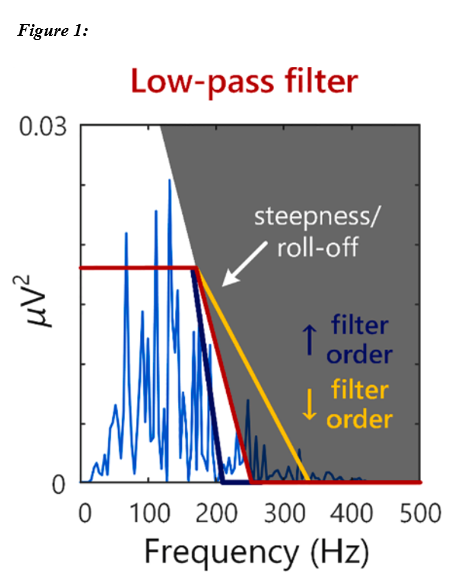Glossary
The first stage of EMG amplification process, that is ideally located close to the electrode. Pre-amplifier should ideally have a high common mode rejection ratio (CMRR), a high input impedance, and be located close to the signal source. The purpose of the pre-amplification stage is to reject noise and interferences close to the signal source and generate a signal with a low-impedance output to help prevent further noise contamination.
(McManus et al., 2021)A change in the mean firing rate of a motor unit during a voluntary muscle contraction. Both motor unit recruitment and rate coding can be used to modulate force production.
(McManus et al., 2021)Often defined as the force or torque at which a motor unit begins to discharge action potentials repetitively. Recruitment threshold has also been estimated from the amplitude of the EMG signal when a motor unit begins to discharge repetitively. The recruitment threshold is sensitive to the task, type of muscle contraction, contributions from other muscles and the history of muscle activation. The force/EMG amplitude at recruitment are indirect approximations of the recruitment threshold of a motor unit. Furthermore, it is often difficult to quantify the force produced by a single muscle in isolation.
(McManus et al., 2021)The translation of a signal into a signal with a single polarity (i. e., positive), obtained by taking the absolute value of the signal at each instant in time. When calculating the RMS or ARV amplitude of an EMG signal, x(t), the mean value of the signal should be subtracted from the total signal length (or the signal should be high-pass filtered) before rectifying (i.e., x(t) should be a zero-mean signal prior to calculating |x(t)|).
(McManus et al., 2021)Resistance is a measure of the opposition to the flow of electric current, measured in Ohm. DC (direct) current will tend to follow the path of least resistance in a circuit. AC current (alternating sinusoidal current of a given frequency) will tend to follow the path of lowest impedance. Impedance alters both the magnitude and phase of current flow and can vary as a function of frequency.
(McManus et al., 2021)The roll-off of a filter describes the rate of change in signal attenuation between frequencies that pass through the filter unattenuated (passband) and frequencies that are attenuated by the filter (stopband), as shown in Figure 1. It is measured in either decibels/decade or decibels/octave, where a decade is a tenfold increase in frequency and an octave is a twofold increase in frequency. Related term: FilterHigher order filters have higher roll-off values (steeper transitions between passband and stopband frequencies).
(McManus et al., 2021)
An analog EMG signal can be sampled in time by taking instantaneous voltage values at a particular rate or sampling frequency (samples/s or Hz). Related terms: Aliasing, A/D conversion.When converting a signal from analog to digital form, the signal must be sampled at a rate which is greater than twice the highest frequency component in the signal bandwidth (Nyquist’s theorem) in order to retain all the information contained within the signal. In practice, the sampling rate should be 2.5 – 3 times higher than the highest frequency component contained within the EMG signal.
(McManus et al., 2021)The relative power of wanted (EMG) to unwanted signal components (noise, interference etc.) that are contained in the overall signal. It measures the quality of the signal. SNR is typically measured on logarithmic scale and expressed in decibels (dB).
(McManus et al., 2021)An array or grid of electrodes can be used to sample the distribution of the EMG signal in space, e.g., across the skin surface (using a surface electrode array) or within the muscle (with multi-channel intramuscular EMG). Related terms: Filter, aliasing, sampling in time.
(McManus et al., 2021)A signal exhibits stationarity when the statistical properties of the processes that generate the signal do not change over time. A signal exhibits quasi-stationarity when it can be assumed that the processes generating the signal are stationary over short time intervals (time windows or epochs used for estimating the signal properties such as ARV, RMS, power spectrum, MNF, MDF, etc.), but can vary when considered over longer time intervals or across different epochs. A signal exhibits nonstationarity when the statistical properties of the processes that generate the signal, and consequently those of the signal itself, change over time. Isometric constant force contractions produce surface EMG signals that are quasi-stationary within time epochs of 0.5–1.0 s.
(McManus et al., 2021)We value your feedback
Let us know how helpful you found the recommendations above and how we can improve: